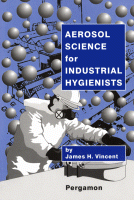Browse content
Table of contents
Actions for selected chapters
- Full text access
- Book chapterAbstract only
Chapter 1 - Introduction to aerosols
Pages 1-10 - Book chapterAbstract only
Chapter 2 - The properties of air and gases
Pages 11-36 - Book chapterAbstract only
Chapter 3 - Properties of aerosols
Pages 37-71 - Book chapterAbstract only
Chapter 4 - The motion of airborne particles
Pages 72-115 - Book chapterAbstract only
Chapter 5 - The optical properties of aerosols
Pages 116-135 - Book chapterAbstract only
Chapter 6 - The inhalation of aerosols
Pages 136-165 - Book chapterAbstract only
Chapter 7 - The fate of inhaled particles
Pages 166-203 - Book chapterAbstract only
Chapter 8 - Standards for health-related aerosol measurement and control
Pages 204-237 - Book chapterAbstract only
Chapter 9 - Aerosol sampling in workplaces
Pages 238-303 - Book chapterAbstract only
Chapter 10 - Direct-reading monitoring of workplace aerosols
Pages 304-331 - Book chapterAbstract only
Chapter 11 - Control of workplace aerosols
Pages 332-388 - Book chapterAbstract only
Chapter 12 - Aerosols and vapours
Pages 389-400 - Book chapterNo access
Postscript
Pages 401-402 - Book chapterNo access
Index
Pages 403-411
About the book
Description
Aerosols in workplace atmospheres have been - and continue to be - a major focus of industrial hygiene. Although there are many existing texts on aerosol science and on occupational health respectively, this new book sets out to be complementary to these and to provide a link between the two fields. In particular, the central concept of worker exposure leads to a structured approach which draws together wide-ranging aspects of aerosol science within the occupational health framework. Introductory chapters are concerned with the nature and properties of aerosols, and how they are generated in the occupational environment. The book then goes on to provide a description of the fundamental mechanical properties of aerosols, in particular those mechanical properties associated with the motion of airborne particles (which govern particle transport, inhalation, deposition, sampling and control). There follows a description of the optical properties of workplace aerosols since these are important in the visual appearance of aerosols and in many aspects of measurement. The central core of the book deals with the processes which govern the nature of exposure to and the subsequent fate and effects of airborne particles, leading to a rational framework for standards, measurement and control. Finally, a chapter is added which relates what has been said about aerosols to gaseous and vapour contaminants. The book is aimed at graduate students and practitioners in industrial hygiene and other occupational (and environmental) health disciplines.
Aerosols in workplace atmospheres have been - and continue to be - a major focus of industrial hygiene. Although there are many existing texts on aerosol science and on occupational health respectively, this new book sets out to be complementary to these and to provide a link between the two fields. In particular, the central concept of worker exposure leads to a structured approach which draws together wide-ranging aspects of aerosol science within the occupational health framework. Introductory chapters are concerned with the nature and properties of aerosols, and how they are generated in the occupational environment. The book then goes on to provide a description of the fundamental mechanical properties of aerosols, in particular those mechanical properties associated with the motion of airborne particles (which govern particle transport, inhalation, deposition, sampling and control). There follows a description of the optical properties of workplace aerosols since these are important in the visual appearance of aerosols and in many aspects of measurement. The central core of the book deals with the processes which govern the nature of exposure to and the subsequent fate and effects of airborne particles, leading to a rational framework for standards, measurement and control. Finally, a chapter is added which relates what has been said about aerosols to gaseous and vapour contaminants. The book is aimed at graduate students and practitioners in industrial hygiene and other occupational (and environmental) health disciplines.
Details
ISBN
978-0-08-042029-5
Language
English
Published
1995
Copyright
Copyright © 1995 Elsevier B.V. All rights reserved
Imprint
Pergamon
